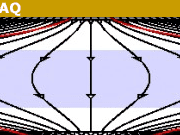Learn about the Big Bang and the Expansion of the Universe
Table of Contents
The “ordinary Big Bang and expansion” (no inflation, no dark energy)
Einstein’s General Relativity allows a solution (FLRW metric) where an empty Universe expands. Imagine you have particles (say, hydrogen atoms) in a cubic grid with exactly 1 light-year between the nearest particles. (We assume their mass is so tiny that this Universe essentially behaves as if it is empty). After each second, the distance between each particle increases by 1 meter. Not because they move, but because space “grows”. That’s the solution.
Even though the empty Universe is expanding without slowing down (the distance between test particles grows by exactly one meter per second, all the time), note that if you look back into the past of this Universe there were times when test particles were much closer together – say, only a billion km apart – and they moved away at exactly one meter per second too. There was a moment when they had to be zero meters apart. That’s the “Big Bang” moment. The moment itself is problematic (singularity!), but any moment after that is not. For example, one microsecond after this moment test particles were 1 micrometer apart. It’s a bit curious that in this scenario expansion seems to be very rapid at first (“density” of test particles falls very quickly), and millions of years later, it looks very gradual, but the expansion rate is constant.
Big Bang with accelerating expansion
Now, if you use General Relativity equations with cosmological constant Λ > 0, the picture changes. The grid of test particles grows not by exactly one meter per second all the time. Now it grows faster with time. If Λ is very small, at first speedup is not noticeable, but later it will be: test particles will not only move away from each other, they will seemingly do it faster with time.
That’s one possibility of what dark energy is – maybe it’s just Λ. However, GR with Λ = 0 but with some other field permeating all space and having appropriate property (negative pressure) will have the same behavior.
Big Bang with matter
How does the presence of matter change this? FLRW metric with a homogeneous distribution of matter will expand too, but expansion will slow down. (Heuristically, “matter will attract itself and try to shrink the Universe”). If there are a lot of matter, the expansion rate can even go to zero and expansion starts to go backward. Between “too little matter, eternal expansion with nonzero rate” and “too much matter, expansion stops and reverses” there is a borderline case where expansion never stops, but its rate falls ever lower, tending to zero with time, but never reaching it (that’s “critical density Universe”). This all was about “normal” matter, with positive pressure. With “negative pressure matter” the effect is the opposite – this was already described in the previous paragraph – that’s “dark energy”.
Big Bang with inflation
Finally, what if the dark energy field is variable (e.g. it has several possible stable values) and one of these values is large (or there may be several such fields)? Alternatively, what if Λ can not only be larger than zero but can be VERY MUCH larger than zero? Nothing unusual will happen, the Universe will behave as described above: the grid of test particles grows faster with time. But very, very much faster. That’s inflation. (If you have a separate “large value dark energy field” for it, that’s an “inflation field”).
If you have an inflationary Universe, even with the matter, it expands astoundingly quickly, essentially becoming empty within a very small fraction of one second. And if then suddenly Λ (or dark energy) goes down to a very small value, you get an empty symmetrical flat expanding Universe. If “Λ going down” releases energy (in the form of the appearance of new particles everywhere), you get a NON-empty symmetrical flat expanding Universe. As of 2016, this model fits observational data rather well.








I’ll look for the previous discussion, rather than distract from the article itself.
I posted my consideration of the potential and kinetic aspects as a heuristic view compared to …
(that’s “critical density Universe”). This all was about “normal” matter, with positive pressure. With “negative pressure matter”
Reference [URL]https://www.physicsforums.com/insights/brief-expansion-universe/[/URL]
as we already agree the cosmological constant isn’t needed for matter to expand…. how does the wording in that sentence make sense? When it comes to critical density?
However it doesn’t particularly matter to me, it’s not my insight article. I rarely visit this forum. ( I have my hands full being a staff member on another lol)
Overall I don’t have a problem with the article, I just feel that line can be improved.
[QUOTE=”Mordred, post: 5438938, member: 351508″]that depends on separation distance.[/QUOTE]
This has been discussed before. “Accelerating expansion” does not mean ##dot{H} > 0## (which is impossible for any FLRW solution). It means ##ddot{a} / a > 0##. That can only be true if ##p < - rho / 3##, as is evident from looking at the second Friedmann equation.
[tex]{scriptsizebegin{array}{|c|c|c|c|c|c|}hline T_{Ho} (Gy) & T_{Hinfty} (Gy) & S_{eq} & H_{0} & Omega_Lambda & Omega_m\ hline 14.4&17.3&3400&67.9&0.693&0.307\ hline end{array}}[/tex] [tex]{scriptsizebegin{array}{|r|r|r|r|r|r|r|r|r|r|r|r|r|r|r|r|} hline S&z&T (Gy)&D_{par}(Gly)&H/Ho \ hline 1090.000&1089.000&0.000373&0.000856&22915.263\ hline 339.773&338.773&0.002496&0.006124&3639.803\ hline 105.913&104.913&0.015309&0.040144&613.344\ hline 33.015&32.015&0.090158&0.248752&105.633\ hline 10.291&9.291&0.522342&1.491191&18.342\ hline 3.208&2.208&2.977691&8.733318&3.292\ hline 1.000&0.000&13.787206&46.278944&1.000\ hline 0.312&-0.688&32.884943&184.082917&0.838\ hline 0.132&-0.868&47.725063&458.475874&0.833\ hline 0.056&-0.944&62.598053&1106.892899&0.832\ hline 0.024&-0.976&77.473722&2639.025517&0.832\ hline 0.010&-0.990&92.349407&6259.261851&0.832\ hline end{array}}[/tex]
Well that depends on separation distance. If you look at just the expansion rate per Mpc expansion rate isn’t accelating. Hubbles constant is decreasing not increasing.
you can see that in Jorrie’s calculator. In the [tex]H_o/H[/tex] column
If you use Hubbles law then it is.
This formula is handy to compare how Hubble constant changes over time as a function of redshift.
[tex]H_z=H_o sqrt{Omega_m(1+z)^3+Omega_{rad}(1+z)^4+Omega_{Lambda}}[/tex]
Grr this site does Sqrt different for latex.
H_z should be on the LHS.
[QUOTE=”Mordred, post: 5438926, member: 351508″]The original FLRW didn’t include the Cosmological term, yet has numerous solutions for matter only universes expanding.[/QUOTE]
Yes, nobody is disputing that. But the original FLRW, with no cosmological constant, does [I]not[/I] have any solutions with [I]accelerating[/I] expansion. Which is what the article is saying.
Precisely. The original FLRW didn’t include the Cosmological term, yet has numerous solutions for matter only universes expanding.
[QUOTE=”Mordred, post: 5438905, member: 351508″]the cosmological constant isn’t required to have expansion.[/QUOTE]
No, but it is required to have accelerating expansion. More precisely, something that has an equation of state that satisfies ##p < - rho / 3## is required to have accelerating expansion; a cosmological constant has that, so does a scalar field. But no ordinary matter or radiation does; any ordinary matter or radiation will have an equation of state that satisfies ##p ge 0##, which can only cause decelerating expansion. That is what the section of the article you quoted from is trying to explain.
On that I agree, there are flaws on the Newtonian thinking. Yes there is a few typos.
I was just glancing at Nordbury and he gives
[tex]M=frac{4}{3}pi r^3rho[/tex]
I still don’t agree with the quoted section from the insight article, for one thing the cosmological constant isn’t required to have expansion.
[QUOTE=”Mordred, post: 5438801, member: 351508″]In that section I’m using the formulas in the sequence of the reference directly from Liddles textbook.[/QUOTE]
And as you can see, there are evidently multiple typos.
In any case, this Newtonian reasoning about potential and kinetic energy implicitly assumes an underlying Newtonian absolute space and time, which makes other predictions that are not correct. So this “derivation” can’t be anything more than a heuristic way of making the Friedmann equations seem intuitively plausible.
Yes that’s why the minus sign here
[tex]E_p=-frac{GMm}{r^2}=-frac{4pi Grho^3 m}{3}[/tex]
In that section I’m using the formulas in the sequence of the reference directly from Liddles textbook.
Oops there is a typo error there.
[tex]E_p=-frac{GMm}{r^2}=-frac{4pi Grho^2 m}{3}[/tex]
Had the wrong exponent value for r, in the textbook he uses V instead of E_p but other that I tried not to make any changes, I’ll check the rest to the book. Hopefully no other typo errors.
he set [tex]M=frac{4pirho r^3}{3}[/tex] on page 18.
Substitutes this into [tex]F=frac{GMm}{r^2}=frac{4pi Grho rm}{3}[/tex]
In equation 3.2.
But then he ends up with
[tex] V=-frac{4pi Grho r^2m}{3}[/tex]
in equation 3.4
Lol
[QUOTE=”Mordred, post: 5438393, member: 351508″]For this we can detail using Newtons laws.
$$
F=frac{GMm}{r^2}
$$
[/QUOTE]
This is force, not potential energy; but you are using it later on as if it were potential energy. Potential energy would be
$$
V = – frac{G M m}{r}
$$
[QUOTE=”Mordred, post: 5438393, member: 351508″]As we’re dealing with test particles we just need the mass relation
$$
M = frac{4 pi rho^3}{3}
$$
[/QUOTE]
No, this should be
$$
M = frac{4 pi r^3}{3} rho
$$
You need to rework the rest of your post in the light of the above.
The other consideration is if you look at the equation of state for matter p=0. However if you understand how the equation of state is calculated the value is given for temperature =0. (No kinetic energy) using the ideal gas laws. ( For matter EoS)
GENERAL RELATIVITY &
COSMOLOGY
for Undergraduates
Professor John W. Norbury
Has a good section on this.
Obviously I can’t post Andrew Liddles textbook but this article covers the same principle in a different set of metrics.
It also does a better job showing the critical density relations.
[URL]http://www.google.ca/url?q=http://www.ita.uni-heidelberg.de/~dullemond/lectures/cosmology_2011/Chapter_4.pdf&sa=U&ved=0ahUKEwje6LD7zYPMAhUGxGMKHRKUAGcQFggYMAI&usg=AFQjCNEyRHgNz1SlmoN01-ko8PRXtmti7g[/URL]
Section 4.3 does the comparison to Newtonian aspects
I find another aspect highly misleading. In a homogeneous and isotropic fluid there is no pressure gradient at any slice of time. Your correlations to positive and pressure matter suggests incorrectly that expansion is due to pressure.
In particular this section
“This all was about “normal” matter, with positive pressure. With “negative pressure matter” the effect is opposite – this was already described in the previous paragraph – that’s “dark energy”.”
Reference [URL]https://www.physicsforums.com/insights/brief-expansion-universe/[/URL]
In my opinion taking a lesson from Andrew Liddle’s Introductory to Cosmology”
You should consider defining expansion in terms of potential vs kinetic energy.
There is some rewording here but this set of equations demonstrate the section
One of the key aspects to understand expansion is to understand the potential and kinetic energy aspects with conservation of energy.
For this we can detail using Newtons laws.
[tex] F=frac{GMm}{r^2}[/tex]
Mass density we will use [tex]rho[/tex] which is the mass per unit volume.
Now assume a field of test particles. Motion and mass currently unimportant.
One of the aspects of the shell theorem in Newtons laws is the test particle will only notice a force from the center of mass.
In a homogeneous and isotropic distribution any test particle or CoM can be used.
As we’re dealing with test particles we just need the mass relation.
[tex]M=frac{4pirho^3}{3}[/tex]
So
[tex]E_p=-frac{GMm}{r^2}=-frac{4pi Grho^3 m}{3}[/tex]
Kinetic energy is [tex]E_k=1/2mdot{r}^2[/tex]
[tex]U=E_k+E_p[/tex]
U is just a dimensionless constant to equate total energy must be set as a constant value.
So the above translates to
[tex]U=frac{1}{2}mdot{r}^2-frac{GMm}{r^2}=-frac{4pi Grho^3 m}{3}[/tex]
Now with the vector relation of the radius to length we can denote the scale factor.
[tex]overrightarrow{r}=a(t)overrightarrow{x}[/tex]
Where a is a function of time. This leads to
[tex]U=frac{1}{2}mdot{a}^2x^2-frac{4pi}{3}Grho a^2x^2 m[/tex]
Multiply each side by [tex]2/ma^2x^2[/tex]
Leads to
[tex](frac{dot{a}}{a})^2=frac{8pi G}{3}rho-frac{kc^2}{a^2}[/tex]
[tex]kc^2=-2U/mx^2[/tex]
[tex]k=-2U/mc^2x^2[/tex]
K is the curvature constant.
Andrew Liddle covers this in better detail to the Einstein field equations later in the book.
Key note you don’t require the cosmological constant for a matter only universe to expand.
A good book showing expansion of a matter only universe is Barbers Rydens “Introductory to Cosmology”
I prefer the solution above for the potential vs kinetic energy aspects.
The end result equation doesn’t include the Cosmological constant.
With the cosmological constant the equation becomes.
[tex](frac{dot{a}}{a})^2=frac{8pi G}{3}rho-frac{kc^2}{a^2}+frac{Lambda}{3}[/tex]
This above better reflects the FLRW metric prior to the discovery of the cosmological constant. It shows you don’t require the cosmological constant to have an expanding universe during any era
“Einstein’s General Relativity allows a solution (FLRW metric) where an empty Universe expands. Imagine that you have particles (say, hydrogen atoms) in a cubic grid with exactly 1 light year between nearest particles. (We assume that their mass is so tiny that this Universe essentially behaves as if it is empty). And after each second distance between each particle increases by 1 meter. Not because they move, but because space “grows”. That’s that solution.”
This is very much subject to interpretation. Note the following:
1) The cosmologically interesting FLRW solutions are NOT empty in that the stress energy tensor is nowhere vanishing.
2) In the limit of actually empty, you have the Milne solution which is just flat SR spacetime in funny coordinates in which the ‘hubble flow’ bodies are inertial with invariant relative velocity accounting for all of the red shift. These relative velocities are all sub-luminal, but the expansion rate (which is a coordinate quantity, NOT an invariant) is super-luminal. Yet, in standard cosmological coordinates, this truly empty solution is the one with maximal expansion rate (of solutions with zero cosmological constant).
3) In the cosmologically meaningful solutions, if you set up Fermi-Normal coordinates, which are the closest analog if Minkowski coordinates in SR, you find that the Doppler of receding bodies is primarily due to relative velocity, and that this relative velocity is sub-luminal.
4) The growth of distance between bodies over time is wholly a coordinate dependent quantity. Distance growth over time requires a choice of foliation, and a choice of time coordinate, neither of which are invariant.
5) As is well known, there is actually no such thing as an unambiguous relative velocity over substantial distance in SR. Thus a claim that recession rate does not represent relative motion is meaningless (because relative motion is ambiguous). However, it is true that parallel transport of a 4-velocity from one event in any spactime to any other event in the spacetime, produces a path dependent relative velocity < c.
[QUOTE=”nikkkom, post: 5425661, member: 339375″]The text is “If “Λ (or dark energy) going down” releases energy…”.
There is that “If” word. It is not a definitive statement.[/QUOTE]
Here is the actual text from your article:
[I]”And finally, what if dark energy field is variable (e.g. it has several possible stable values) and one of these values is large (or there may be several such fields)? Alternatively, what if Λ can not only be larger than zero, but can be VERY MUCH larger than zero? Nothing unusual will happen, the Universe will behave as described above: grid of test particles grows faster with time. But very, very much faster. That’s inflation. (If you have a separate “large value dark energy field” for it, that’s “inflaton field”).”[/I]
This clearly implies that “inflation field” = “variable dark energy that can have a large value”. But that’s not the current mainstream model for inflation; in that model, the inflaton field is not the same as what we currently observe as dark energy, they just happen to have a similar property (that they cause accelerating expansion). If you want to mention the possibility that what we currently observe as “dark energy” is just the very small remnant of the inflaton field that’s left over after the end of inflation, you should make clear that it’s just a speculative hypothesis, since, as Chalnoth pointed out, it is clearly not the mainstream theory.
Also, the inflaton field is not the same as ##Lambda##, even a ##Lambda## that is very much larger than zero. Nor can a variable dark energy be the same as ##Lambda##. Elsewhere in the article you are consistently using ##Lambda## to refer specifically to the cosmological [I]constant[/I]–i.e., it is by definition the same everywhere in spacetime. You should keep to the same usage at the end of the article as well, and in that usage, ##Lambda## can’t change, so obviously it can’t be the inflaton field, since that has to change from a very large value to zero (in the current mainstream model) at the end of inflation, and it can’t be a variable dark energy either. (You recognize this earlier where you say that a universe with ##Lambda = 0## but some other field having similar properties could possibly explain the observed “dark energy”.)
[QUOTE=”PeterDonis, post: 5425650, member: 197831″]Your statement that “##Lambda## going down releases energy (in a form of appearance of new particles everywhere)” implies that the end of inflation involved “##Lambda## going down”, which implies that Lambda = inflaton field = dark energy. [/QUOTE]
The text is “If “Λ (or dark energy) going down” releases energy…”.
There is that “If” word. It is not a definitive statement.
Secondly, the statement does not say that we are sure it’s Λ going down. It may be dark energy (whatever that is) going down.
[QUOTE=”nikkkom, post: 5425644, member: 339375″]The text does not imply that we know that Lambda = inflaton field = dark energy.[/QUOTE]
Your statement that “##Lambda## going down releases energy (in a form of appearance of new particles everywhere)” implies that the end of inflation involved “##Lambda## going down”, which implies that Lambda = inflaton field = dark energy. If you don’t intend that implication, then I think you need to reword the text.
[QUOTE=”Chronos, post: 5425637, member: 10970″]Any relationship between dark energy [Lambda] and inflation is an idea that is not widely shared among cosmologists. While there is a general consensus that matter froze out of the inflaton field, there is no firm evidence the inflaton field is related to Lambda. See [URL]https://medium.com/starts-with-a-bang/ask-ethan-107-are-inflation-and-dark-energy-connected-6ef979bee115#.eqzjrm0qf[/URL] and [URL]http://supernova.lbl.gov/~evlinder/defaq.html[/URL] for further discussion.[/QUOTE]
The text does not imply that we know that Lambda = inflaton field = dark energy.
In general, the text is meant as a FAQ for the new people who regularly pop in the Cosmology forum asking “what is that Big Bang thing? What does it mean that expansion is accelerating?”; it is not intended to be an in-depth discussion.
Any relationship between dark energy [Lambda] and inflation is an idea that is not widely shared among cosmologists. While there is a general consensus that matter froze out of the inflaton field, there is no firm evidence the inflaton field is related to Lambda. See [URL]https://medium.com/starts-with-a-bang/ask-ethan-107-are-inflation-and-dark-energy-connected-6ef979bee115#.eqzjrm0qf[/URL] and [URL]http://supernova.lbl.gov/~evlinder/defaq.html[/URL] for further discussion.
Observational data supports the theory that inflation did happen.
And observational data supports the theory that Universe is not empty.
I object to this in the closing paragraph – “Λ going down” releases energy (in a form of appearance of new particles everywhere), you get a NON-empty symmetrical flat expanding Universe. As of 2016, this model fits observational data rather well.”
What observational evidence supports this assertion?
A questão é, manter o sistema em equilíbrio exige que a mudança cosmológica seja constante. Não voltando a ideia de Albert Einstein mas observando o efeito de partículas ordenadas demonstrados no LHC. O palco de Isaac Newton explicava que o espaço não era alterado, porém com as observações feitas no LHC podemos claramente ver que o palco afeta a ação e a ação afeta o palco. A velocidade em que é alterado e muito rápida quase que imperceptível!
Congrats nikkkom! I think you should be able to still make edits if you need to.
Yes, I think replacing “expansion speed” with “expansion rate” everywhere in the text is okay.
Good short but all cases has been examined … very nice article…
Excellent intro to cosmology using so few words!
You wrote: “[I]It’s a bit curious that in this scenario expansion seems to be very rapid at first (“density” of test particles falls very quickly), and millions of years later, it looks very gradual, but expansion speed is in fact constant[/I].”
This is well stated, but I just have a concern about the term “[I]expansion speed[/I]” in that sentence, which has caused some confusion in the past. I think what you intended is normally referred to as the “recession rate” (between two particles) because the speed of expansion depends on the size of the area that one considers. If it will not lengthen the article too much, it may also be useful if you could bring in the expansion rate or Hubble value (H) somewhere.
Nice explanation of expansion, Nikkkom!
"Einstein’s General Relativity allows a solution (FLRW metric) where an empty Universe expands. Imagine that you have particles (say, hydrogen atoms) in a cubic grid with exactly 1 light year between nearest particles. (We assume that their mass is so tiny that this Universe essentially behaves as if it is empty). And after each second distance between each particle increases by 1 meter. Not because they move, but because space “grows”. That’s that solution."This is very much subject to interpretation. Note the following:1) The cosmologically interesting FLRW solutions are NOT empty in that the stress energy tensor is nowhere vanishing.2) In the limit of actually empty, you have the Milne solution which is just flat SR spacetime in funny coordinates in which the 'hubble flow' bodies are inertial with invariant relative velocity accounting for all of the red shift. These relative velocities are all sub-luminal, but the expansion rate (which is a coordinate quantity, NOT an invariant) is super-luminal. Yet, in standard cosmological coordinates, this truly empty solution is the one with maximal expansion rate (of solutions with zero cosmological constant).3) In the cosmologically meaningful solutions, if you set up Fermi-Normal coordinates, which are the closest analog if Minkowski coordinates in SR, you find that the Doppler of receding bodies is primarily due to relative velocity, and that this relative velocity is sub-luminal. 4) The growth of distance between bodies over time is wholly a coordinate dependent quantity. Distance growth over time requires a choice of foliation, and a choice of time coordinate, neither of which are invariant.5) As is well known, there is actually no such thing as an unambiguous relative velocity over substantial distance in SR. Thus a claim that recession rate does not represent relative motion is meaningless (because relative motion is ambiguous). However, it is true that parallel transport of a 4-velocity from one event in any spactime to any other event in the spacetime, produces a path dependent relative velocity < c.
Congrats nikkkom! I think you should be able to still make edits if you need to.